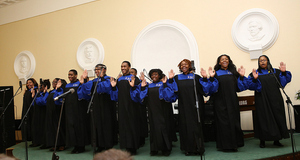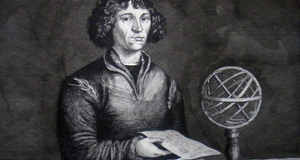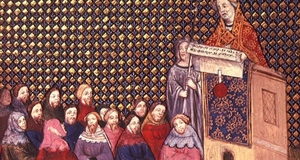William Bradford, The Puritan Ethic, & The Mayflower Compact
By
2010, Vol. 2 No. 11 | pg. 2/2 | « In response to this need, the Pilgrims drafted a signed agreement called the Mayflower Compact. The agreement was signed by nearly all of the free adult male passengers, and formed a “civill body politick,” granting the signors governing power and the ability to oversee the obligation of all the settlers to obey the aforementioned laws (Magill 75). The Compact was not intended to be a constitution, but was in fact, simply an extension of the rules and covenant provided by the church regarding civil circumstances. It afforded its signors the ability to not only make and enforce laws, but to elect officials to administer the government of the settlement. Because the Plymouth settlers landed outside the realm of their original patent and charter, and were not able to secure a new one, the Mayflower Compact remained the sole framework and constitution of government for the new colony (Sharp 10). Through the Mayflower Compact, a government through consensus was formed. Leaders were to be chosen by the majority, and the body politic was to submit to rule by them (Palmer 276). The Pilgrims founded what would essentially be considered to be a Democratic government, ruled by officials elected by majority consensus. Magill asserts that, “the Pilgrims who landed at Plymouth in 1620 would have been appalled at the thought of being called democrats.” They did, however, lay the foundation for the future democratic government that would be put in place for the United States in the following century (Magill 76). The Compact was finally put into application following the election of the colony’s first governor, John Carver (Palmer 276). After Carver’s death the following April, William Bradford was elected governor (Davis 10). Bradford was re-elected to the position of governor annually for 35 years, only five of which did he serve only as assistant to the governor (McGiffert 362). Under the Mayflower Compact, the “General Court” was created. It was comprised of all the freemen (servants were excluded). The court met several times each year, elected the governor and his assistants, and passed necessary laws for the settlement. The members of the court, which included all free men of the colony, voted directly in an assembly. Participation in this assembly also carried with it some responsibility. All freemen were expected to attend each and every General Court session. Those who did not attend faced severe fines. The governor maintained a majority of power, since the General Court was an assembly of regular citizens, and was not in regular session much of the time. Following growth of the colony, it became difficult to remain orderly and efficient in this method of assembly. The General Court transitioned into a representative assembly, and later, as new towns were formed, proxy voting became the norm. Through proxy voting, freemen assembled in their individual towns and sent representatives to attend the General Court sessions on their behalf.After the General Court did away with the last of the colony-wide meetings of freemen for the purpose of electing the governor and assistants, it became a formal representative assembly. In doing so, the General Court took some initiative away from the governor, specifically claiming the right to tax, declare war and frame legislation. The governor maintained the power to execute laws and possessed power of arrest (Palmer 276). This final representative assembly system was very similar to that of the British Parliament and the American Congress. There was a definite system of checks and balances in place, and though the original Compact was brought out as an extension of the church’s covenant, religion was effectively separated from the business of governing the colony. Other connections can be drawn from the Mayflower Compact to a later document that is important to American history. Deetz illustrates a contrast between the Mayflower Compact and the Declaration of Independence. In his view, Deetz points out that the Compact “stresses the larger community, and the individual is not considered: ‘[we]... covenant and combine ourselves together in a civil body politic ... and promise due submission to the general good of the colony.’” He goes on to quote the Declaration, “...that all men are created equal, that they are endowed by their Creator with certain unalienable rights, that among these are Life, Liberty, and the pursuit of Happiness...,” pointing out the difference between the “civil body politic” and “all men.” This difference between the two documents, according to Deetz, is easily understood, and also “peculiarly suitable to the needs of the people for whom it was written” (Deetz 158-59). Certainly, the Mayflower Compact was a document that not only provided the Pilgrim colonists with a reasonable and somewhat objective form of government, but also laid the foundation for the future government of the United States of America. In congress with the Puritan Ethic, and through William Bradford, the scope of the Compact grew into a large, democratic representative government that reflected the values of the Puritans. Puritanism provided the settlers with the means to a political revolution, albeit somewhat inadvertent. Their Christian character and ethic framed the vision the Pilgrims had for their colony: It was their “Promised Land.” That level of character created a benchmark and has remained unmatched throughout the history of the United States, with its influences still being felt even in modern day politics. One only has to look at the British Parliament or the U.S. Congress to see the influence of the government model forged by William Bradford, the Puritan Ethic and the Mayflower Compact. ReferencesBelasco, Susan, Linck Johnson, eds. The Bedford Anthology of American Literature, Volume One: Beginnings to 1865. Boston: Bedford / St. Martin’s, 2008. Bowden, Henry Warner, Mark A. Noll. Puritanism / Puritans. May 1997. 24 November 2008. <http://mb-soft.com/believe/txc/puritani.htm>. Davis, William T. ed. Bradford’s History of Plymouth Plantation 1606-1646. New York: Barnes & Noble, Inc., 1959. Deetz, James. In Small Things Forgotten: The Archeology of Early American Life. Garden City: Anchor Books, 1977. Finch, Martha L. Encyclopedia of Religion and Nature, Vol. 2. London:Thoemmes Continuum, 2005. Leslie, Steven, Sidney Lee, eds. The Dictionary of National Biography. Vol. II. London: Oxford University Press, 1917. Magill, Frank N., ed. Great Events From History: American Series. Englewood Cliffs: Salem Press, 1975. McGiffort, Michael. American National Biography. New York: Oxford University Press, 1999. Morison, Samual Elliot. The Oxford History of the American People. New York: Oxford University Press, 1965. Palmer, Aaron J. Dictionary of American History, 3rd Edition. New York: Charles Scribener’s Sons, 2003. Sharp, Harold S. Footnotes to American History. Metuchen: The Scarecrow Press, Inc., 1977. Suggested Reading from Inquiries Journal
Inquiries Journal provides undergraduate and graduate students around the world a platform for the wide dissemination of academic work over a range of core disciplines. Representing the work of students from hundreds of institutions around the globe, Inquiries Journal's large database of academic articles is completely free. Learn more | Blog | Submit Latest in History |


















